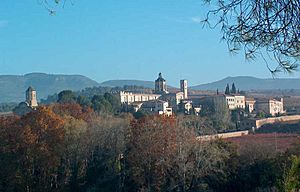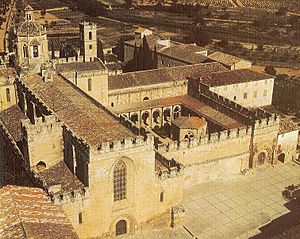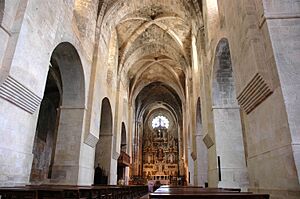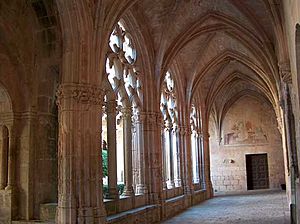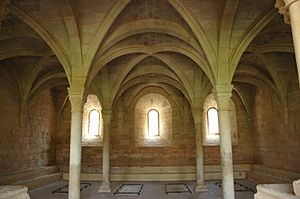Santes Creus facts for kids
The Monastery of Santa Maria de Santes Creus is an old Cistercian monastery in Catalonia, Spain. It's located in a village called Santes Creus, in the area of Aiguamúrcia.
This impressive building was first built in the 12th century. It became very important in the 13th century. This was because King Peter III of Aragon wanted to be buried there. His son, King James II, also chose it as his burial place. Many other important families then decided to be buried at Santes Creus too. This brought the monastery a lot of fame and wealth from their gifts.
Santes Creus is part of a special group called the "Cistercian triangle." The other two monasteries are Vallbona de les Monges and Poblet Monastery. These three places helped make the Cistercian order strong in Catalonia during the 1100s.
Contents
Exploring the Monastery's Past
The story of Santes Creus began in 1158. At that time, some local lords gave the village of Santes Creus to a group of monks. These monks came from another monastery called Valldaura.
To officially start a new monastery, they needed permission from the Pope. Pope Alexander III gave his approval. Building work on the monastery then started in 1174. The main parts of the complex were finished by 1225.
Royal Connections and Changes
King Peter III of Aragon chose Santes Creus as his final resting place. His son, King James II, and James's wife, Blanche of Anjou, were also buried here. King James II made some big changes to the monastery. He added royal rooms for himself. He also rebuilt the old Romanesque cloister in a newer Gothic style. A dome was added to the church's center. Later, under King Peter IV, strong walls were built around the monastery.
However, after Peter IV, the royal family started favoring the Poblet Monastery more.
Later Years and National Monument Status
The Santes Creus monastery continued to grow in the 1600s and 1700s. But in 1835, a law changed things. The Cistercian monks had to leave the monastery. After that, no more building work was done. In 1921, the monastery was recognized as an important national monument.
What the Monastery Looks Like
The monastery was built following the rules of the Cistercian order. It included a church, a cloister, and rooms for meetings and sleeping. There was also a dining hall and a special room for writing. The buildings are made of honey-colored stone. Many of the main buildings have crenellations, which are like the battlements you see on castles.
The Church Building
The church was started in 1174 and finished around 1225. It was officially opened in 1211. It has a shape like a Latin cross. It has a main area (nave) and two side aisles. The arms of the transept (the cross part) are as wide as the nave. Each arm ends in a small chapel. The main altar area is rectangular.
Above the center of the church is a tall, eight-sided dome. This dome is in the Gothic style. It has a smaller, decorative tower on top from the Baroque period.
The front of the church has a Romanesque entrance from the 12th century. Above it is a large Gothic stained-glass window. The back of the church has a round rose window. Below it are three small pointed windows. These are now hidden by the main altar inside.
Inside, each section of the church has a vaulted ceiling. The interior is mostly plain, as was common for Cistercian churches. The only decorations are the royal tombs and an altarpiece from 1640.
Royal Burial Places
The tomb of King Peter III was made between 1291 and 1307. It was created by an artist named Bartomeu de Girona. This tomb looks very rich and detailed. It has an urn with images of saints around it. It sits on a red stone bath that was brought from far away.
The tomb for King James II and his wife Blanche was made by Bertran Riquer. This was done between 1313 and 1315. Their tombs are made of marble. They show the king and queen wearing Cistercian robes. They are lying on top of the tomb.
The Cloister: A Peaceful Courtyard
The original cloister was built in the Romanesque style. It dated back to the late 1100s or early 1200s. Today, only a small, six-sided central shrine remains from that first cloister. This shrine holds the laundry area.
King James II asked for the old cloister to be mostly taken down. It was replaced with a new Gothic cloister. This new design was started by Reynard of Fonoll and finished by Guillem de Seguer. The designs in the upper parts of the cloister's arches are very detailed. They show different styles, from English to Catalan Gothic. The columns have carved tops with plants, animals, and people. Some even show scenes from the Bible.
In the walls of the cloister, you can find tombs of several important Catalan noblemen. There are also some old paintings, including one of the Annunciation.
You can enter the cloister from the monastery's main square. This entrance is called the Porta Reial (Royal Gate). It is a Romanesque doorway.
Chapter House and Dormitory
The chapter house is where the monks met each day. It is in the typical Cistercian style. It is located on the eastern side of the cloister. It gets morning light through three windows. The entrance from the cloister has a Romanesque doorway. On each side of the door are large windows. These three openings form a triple archway. The room is square and has nine vaulted sections. These are supported by four central columns.
The dormitory was a very large hall, about 46 by 11 meters. It was plain and had no walls to separate sleeping areas. The monks originally slept on straw mattresses on the floor. The wooden roof is held up by stone arches. These arches spring from supports in the side walls.
Gallery
-
A detailed carving of a figure playing bagpipes on a cloister column top.
See also
 In Spanish: Monasterio de Santes Creus para niños
In Spanish: Monasterio de Santes Creus para niños
- Bonanat de Vilaseca
- Gothic altarpiece of Santes Creus


